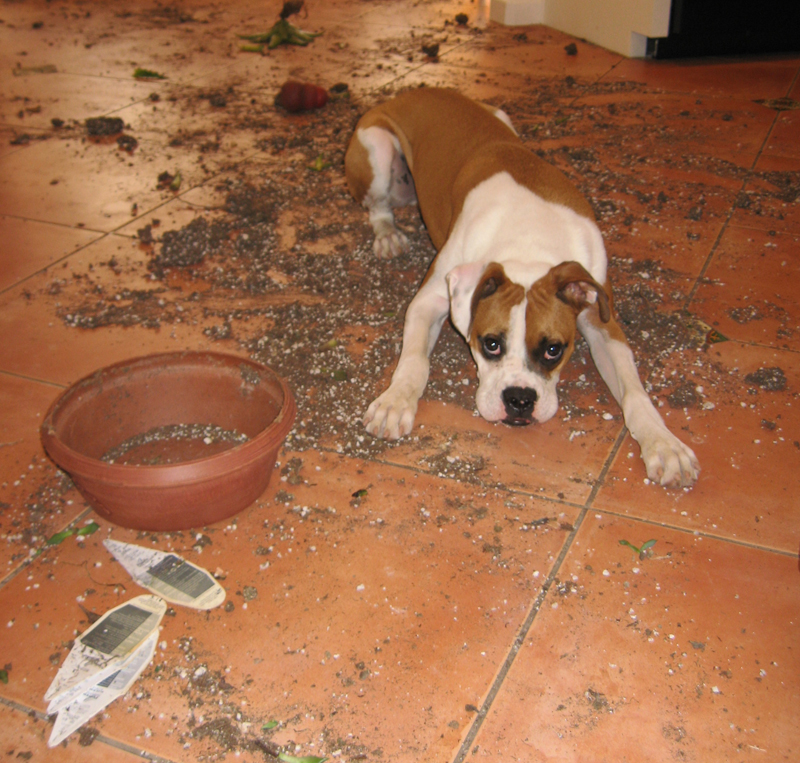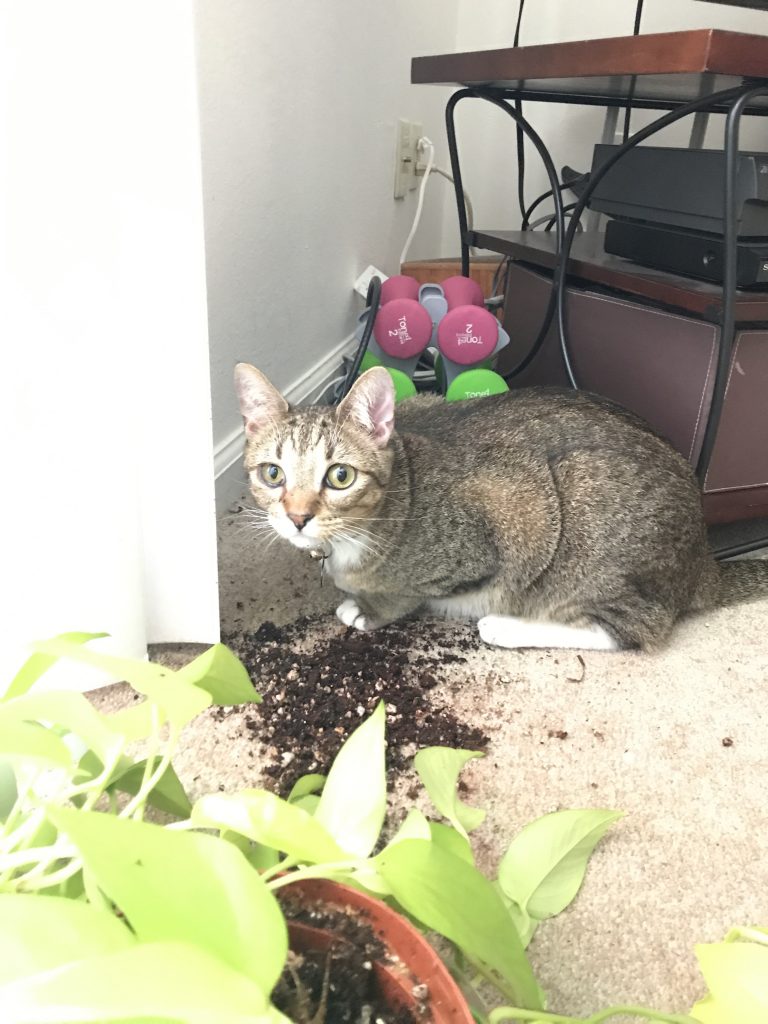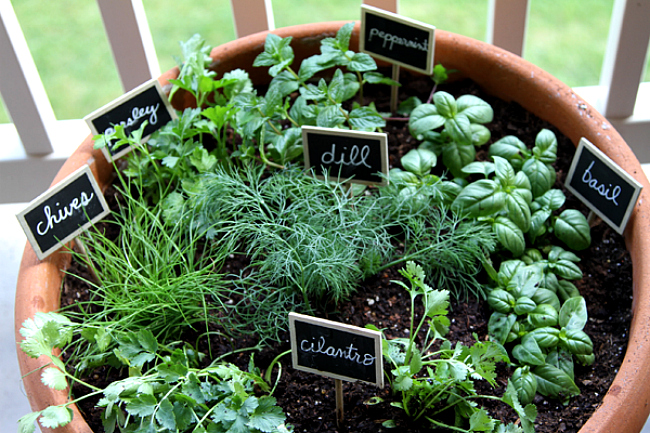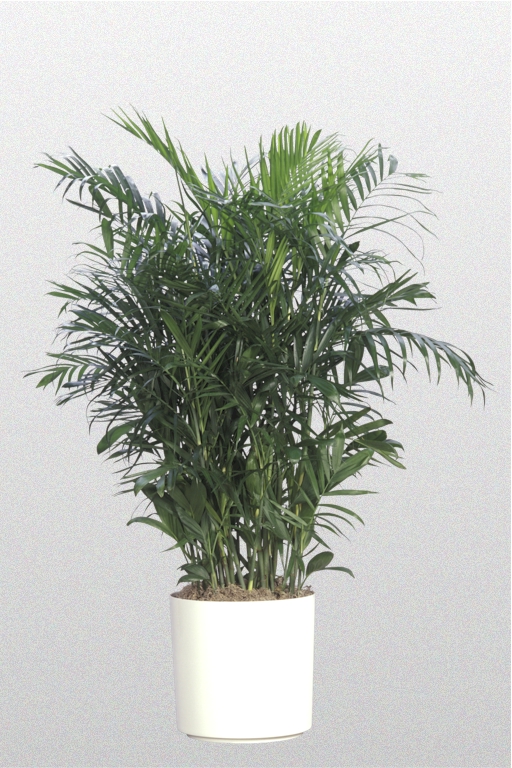Americans love their pets. They’re family to many of us. It’s estimated that 78 million dogs and 85.8 million cats are owned in the United States. Approximately 44% of all households in the U.S. have a dog, and 35% have a cat.
When your animals are your family, keeping them safe becomes a top priority. When you’re making your home pet-friendly and pet-safe, be sure you take your houseplants into consideration. While I’ve owned many dogs and cats and never had a problem, it’s a big enough concern to the American Society for the Prevention of Cruelty to Animals (ASPCA) to maintain information at its national Animal PoisonControl center about toxic plants.

Inquisitive or bored pets like eight-month-old Boxer puppy Mario can get into your indoor plants. Be sure they won’t be hurt by anything they might eat or chew. Photo: Courtesy Gayle Falkenthal
Good Earth Plant Company encourages you to use plants to clean the air, improve your connection to nature, and add color and interest to your home. But you need to be sure to choose nontoxic plants to keep your companions out of harm’s way, especially if you’ve got a curious cat or a digging dog who gets into trouble when you aren’t watching. We’ve rounded up a list of indoor plants safe for cats and dogs.
Some of these categories are tricky. Let’s start with ferns. True ferns are safe for pets. But there are several types of plants called “ferns” which aren’t really in the same scientific Pteridophyta plant family, like asparagus ferns. True ferns such as Boston and maidenhair ferns are OK. Our advice: don’t guess if aren’t sure. For this reason, we’re not listing ANY ferns.
Kitchen herbs are another category where some plants are OK, and some are not. Basil, sage, and thyme are safe. But did you know lavender and oregano are not? If you are growing kitchen herbs, it’s best to double check and try to keep them completely out of your pet’s reach.
Our recommendations are 100 percent safe, even if your dog or cat decided to dig them up and make a meal or a mess out of them. Not that your sweet little terrier would do such a thing, even though digging is in their DNA. Right?
Top Ten House Plants Safe For Your Pets
- Orchids: The Phalaenopsis orchid is a safe plant, easy to grow and forgiving of mistreatment. The blooms can last for weeks. Safe for pets, but take care they won’t tip over a top heavy orchid bloom in a small container.
- Bromeliads: Along with orchids, we use a lot of bromeliads at Good Earth Plants for our clients. We love the variety of bright colored leaves produced by this evergreen plant, and they can tolerate a wide variety of growing conditions. They make a great addition to any room, and they aren’t harmful to pets.
NOTE: These are two of our favorite Plantscaping choices for our own clients. They fit in to all types of interior design, don’t take too much space and are forgiving of less than great conditions. We recycle our gently used orchids and bromeliads at our quarterly plants sales. Mark your calendar, the next one coming up is on Friday, July 29.
- African Violets: Low maintenance, and does well without a lot of light. They come in many different colors and flower shapes.
- Lipstick Plant: This tropical native loves bright light and it can even be grown outdoors in warm months. The fun looking red blooms give the plant its name: they resemble tubes of lipstick. The Lipstick Plant is a member of the Peperomia family and all of these plants are safe for cats and dogs.
- Spider Plant: One of the most efficient of all house plants processing toxins in indoor air like formaldehyde, toluene, and xylene. Did you know spider plants help scrub the air in a room that has been freshly painted? They are easy to grow and non-toxic. This easy going plant will thrive nearly anywhere. You can plant it in hanging containers where its offshoots trail nicely, keeping them out of the way of inquisitive pets.
- Bamboo Palm: Are you near a major road or highway where there are a lot of exhaust fumes? The Bamboo Palm is one of the most efficient plants for processing gasoline fumes. It is also an excellent natural air humidifier.
- Areca Palms: One of the very best plants for scrubbing the air, areca palms are fairly easy to care for. It’s important not to over-water it. Check the soil below the surface and water when it begins to feel dry. Let your areca palm gradually acclimate to indoor lighting by first placing it outside in a part-shade area. After a few weeks, bring it inside to its permanent bright location. These can grow to be large plants up to 15 – 20 feet tall. They make a dramatic display in a beautiful pot, and even a big dog would have trouble knocking one over.
- Prayer Plant: These small plants grow to be six to eight inches tall. They are great for small spaces. They are easy to grow and provide a nice little burst of color with red, cream and green leaves. Secure them on a bookshelf where your pets won’t be tempted.
- Zebra Plant: These small plants with striped leaves are easy to grow, but they do like a lot of light indoors.
- Cast Iron Plant: The name says it all! The Aspirdistra elatior is tough and seems healthier the more you neglect it. It will thrive even in low light, stand up to extreme heat, and doesn’t mind infrequent watering. It doesn’t like soggy soil at all. You could put a Do Not Disturb sign on this plant. Completely harmless to your pets, too.
If you aren’t sure about the safety of a plant, refer to the ASPCA’s helpful online database where you can check any plant. Some interesting trivia: the top searches at press time on the website were for Sago Palms, Tulips, Azaleas, and Lilies. All of them are toxic to dogs, cats, and horses.
If you think that your animal is ill or may have ingested a poisonous substance, contact your local veterinarian or the ASPCA’s 24-hour emergency poison hotline directly at 1-888-426-4435.

Good Earth Plants office administrator Erin Lindley caught her cat Luke in a naughty moment with one of her own plants.
Try your best to eliminate temptation and place all houseplants out of reach. It will save you from cleaning up a mess, plus prevent possible digestive problems in your pets. If your pet ever does ingest a plant, make sure to watch it closely for any signs of a negative reaction. Just because a plant is nontoxic for cats and dogs doesn’t mean eating it won’t make them feel pretty sick.
One last bit of advice for pet owners: pay attention also to your choice of planters, the potting mixes, and any decorative items you use with your plants. Secure your plants in an area where they won’t invite a curious dog or cat turning them into a toy and sending them crashing over. The broken pieces of a pot could hurt a pet, as well as babies and toddlers who crawl or walk over them.
Potting mix can be a problem. Dogs and cats who love to chew may get into trouble if the mix contains a large amount of bark or mulch. Cocoa bean mulch is made from real cocoa bean shells. It smells like chocolate. Chocolate contains theobromine and caffeine. The same substances are found in cocoa bean mulch. Both cocoa beans and chocolate are poisonous to dogs. Dogs that swallow too much can have vomiting, diarrhea, a very fast heart rate, tremors, and seizures. In rare cases, it can kill a dog.
Some people use discarded coffee grounds as a fertilizer. In most cases, pets aren’t attracted to them, but there is always an exception. Coffee grounds are especially harmful if ingested by a pet. There are better ways to fertilize your plants indoors. Don’t put your pets are risk. Toss the grounds in your compost pile or toss them out.
Avoid decorating your plants with little figurines, toys, or any baubles a pet (or a baby!) could chew, swallow and choke on or cause gastrointestinal damage. Even when you think you have items safely out of the way, pets who have relentless curiosity can give you a nasty surprise. Don’t gamble.





